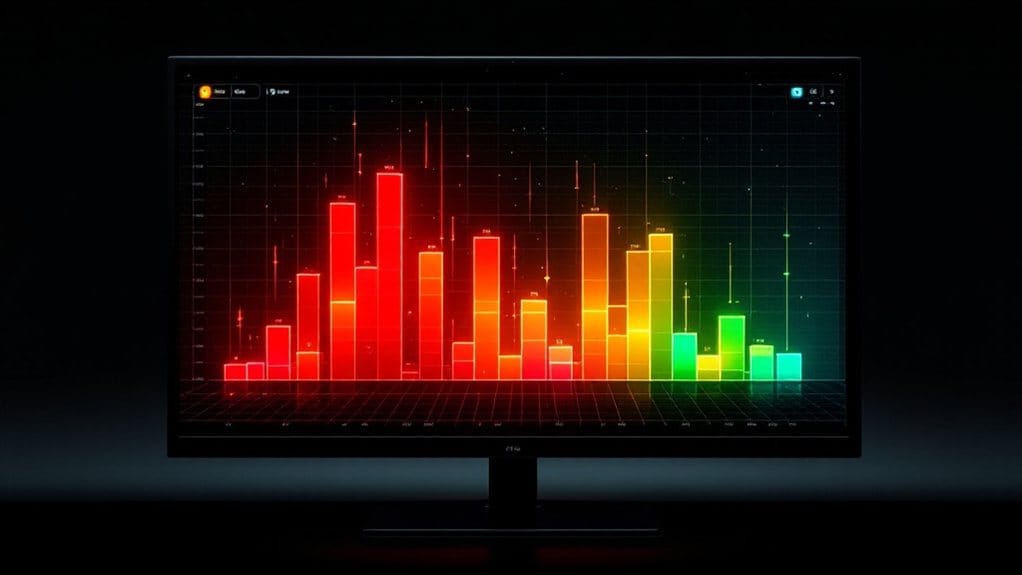Cryptocurrency heat maps provide traders with dynamic visual representations of market performance, utilizing color-coding to display price movements across multiple digital assets. These interactive tools present real-time data through size-differentiated tiles, where green indicates price increases and red shows decreases, while tile dimensions reflect metrics like market capitalization. Traders can monitor market sentiment, identify trends, and make informed investment decisions through this all-encompassing visualization system. Understanding these crucial trading tools reveals deeper insights into market dynamics and potential opportunities.

In the constantly changing landscape of cryptocurrency trading, heat maps serve as indispensable visual tools that transform complex market data into intuitive, color-coded representations. These sophisticated visualizations employ a spectrum of colors, typically using green to indicate price increases and red to show decreases, with varying intensities reflecting the magnitude of market movements. The size of individual tiles or boxes within the heat map corresponds to significant metrics such as market capitalization or trading volume, providing traders with a thorough market overview at a glance. Raw blockchain data undergoes extensive data processing methods before visualization. Users can easily customize their view by selecting between USD or BTC market perspectives for more targeted analysis.
Cryptocurrency heat maps operate through real-time data integration, continuously updating to reflect the latest market conditions and enabling traders to monitor multiple digital assets simultaneously. The interactive nature of modern heat maps allows users to hover over or click on specific cryptocurrencies to access detailed information, including precise price changes, trading volumes, and historical performance data. This functionality proves particularly valuable when analyzing market sentiment across different time frames, from minutes to months, helping traders identify both short-term opportunities and long-term trends. Implementing dollar-cost averaging strategies alongside heat map analysis can help investors minimize the impact of market volatility.
The practical applications of cryptocurrency heat maps extend beyond basic market analysis, serving as powerful tools for risk management and investment decision-making. Traders can quickly identify market outliers, spot emerging trends, and assess general market sentiment by observing patterns of buying and selling pressure. The visual representation of market data simplifies complex analysis processes, making it accessible to both novice and experienced traders while maintaining the depth of information necessary for sophisticated trading strategies.
Heat maps excel in providing context for market movements, allowing traders to understand how individual cryptocurrencies perform relative to the broader market. This contextual awareness proves vital for portfolio management and risk assessment, as traders can readily identify which assets are outperforming or underperforming their peers.
Through the strategic use of heat maps, traders can develop more informed trading strategies, optimize their portfolio allocation, and maintain a thorough understanding of market dynamics in the fast-paced cryptocurrency ecosystem.
FAQs
Which Software Provides the Most Accurate Cryptocurrency Heat Map Data?
Coin360 consistently provides the most accurate cryptocurrency heat map data, offering real-time visualization of market movements with precise price updates and volume metrics.
The platform’s sophisticated algorithms process data from multiple exchanges, ensuring thorough market coverage, while its color-coded system effectively displays price variations across different timeframes.
Furthermore, Coin360’s integration with major data providers improves its reliability for both retail and institutional traders.
Can Heat Maps Predict Market Crashes Before They Happen?
Heat maps cannot definitively predict market crashes but can provide early warning signals through visualization of market stress points.
By displaying concentrations of liquidation orders and extreme price movements, heat maps help identify potential trigger points where cascading sell-offs might occur.
The tool’s effectiveness increases when combined with other technical indicators, volume analysis, and market sentiment data to forecast possible downturn scenarios.
How Often Should Traders Check Heat Maps for Optimal Trading Decisions?
Trading frequency for heat map monitoring should align with specific trading strategies: day traders should check every 15-30 minutes during active sessions, while swing traders can review maps 2-3 times daily.
Long-term investors may benefit from daily or weekly analysis, focusing on broader market trends.
During high-volatility periods, all traders should increase their monitoring frequency to adapt to rapidly changing market conditions.
Do Cryptocurrency Heat Maps Work Effectively During High Market Volatility?
Cryptocurrency heat maps demonstrate significant effectiveness during high market volatility by providing real-time visual representations of price movements and trading activity.
These tools excel at revealing liquidity clusters and rapid market shifts, enabling traders to identify emerging trends quickly.
However, their reliability depends on data quality and should be complemented with additional analytical tools.
During volatile periods, heat maps are particularly valuable for risk management and sentiment analysis.
What Are the Potential Risks of Relying Solely on Heat Maps?
Relying solely on heat maps presents significant risks in cryptocurrency trading.
These visualizations oversimplify complex market dynamics, potentially missing vital interdependencies between different market factors. The static nature of heat maps fails to capture rapid market changes, while their subjective interpretation can lead to biased trading decisions.
Furthermore, heat maps’ limited predictive capabilities and inability to account for qualitative risks can result in incomplete market analysis and flawed trading strategies.









